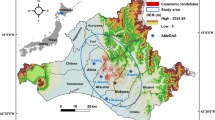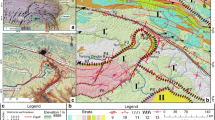Abstract
The 2018 Hokkaido Eastern Iburi Earthquake struck the eastern Iburi region (epicenter: 42.691°N, 142.007°E, depth: 37.0 km) of Hokkaido, Japan, at 3:07.59 JST, September 6, 2018 (18:07.59, September 5, 2018 UTC). Many shallow landslides were triggered by this Mw 6.6 (Mj 6.7) earthquake. The basement complex in the affected area (sedimentary rocks) is covered with thick pyroclastic fall deposits derived from the Tarumae Volcano, etc., and the strong seismic shocks triggered shallow landsliding of them. Shallow landslides moving along valley type topography traveled greater distances than those moving along planar slope topography. Some shallow landslides occurred on relatively gentle slopes (< 30°). The earthquake also induced several large-scale deep-seated landslides, including one that has formed a landslide dam in the Hidaka-horonai River. Landslides were densely distributed over hilly regions (elevation: 200–400 m) within an area of approximately 400 km2 in Atsuma (landslides caused 36 deaths), Abira, and Mukawa, and the number of landslides and the total area of the landslides were the largest in Japan ever since the Meiji Era (1868–1912). The catchments where shallow landslides were concentrated were severely devastated.















Similar content being viewed by others
References
Furuichi T, Osanai N, Hayashi S, Izumi N, Kyuka T, Shiono Y, Miyazaki T, Hayakawa T, Nagano N, Matsuoka N (2018) Disastrous sediment discharge due to typhoon-induced heavy rainfall over fossil periglacial catchments in western Tokachi, Hokkaido, northern Japan. Landslides 15(8):1645–1655. https://doi.org/10.1007/s10346-018-1005-1
Furukawa R, Nakagawa M (2010) Geological map of Tarumae volcano. https://gbank.gsj.jp/volcano/Act_Vol/tarumae/index-e.html. Accessed 18 Dec 2018
Hokkaido development bureau (2018a) The final report of technical committee for prediction for climate change in Hokkaido region (water-related field). https://www.hkd.mlit.go.jp/ky/kn/kawa_kei/splaat000000vdyw-att/splaat0000019r1f.pdf. Accessed 20 Dec 2018
Hokkaido development bureau (2018b) Water level of landslide dam at Hidaka-horonai river. https://www.hkd.mlit.go.jp/mr/category/suii.pdf. Accessed 11 Dec 2018
Hsü KJ (1975) Catastrophic debris streams (Sturzstroms) generated by Rockfalls. Geol Soc Am Bull 86(1):129–140. https://doi.org/10.1130/0016-7606(1975)86%3C129:CDSSGB%3E2.0.CO;2
Ishii Y, Kodama Y, Nakamura R, Ishikawa N (2004) Water balance of a snowy watershed in Hokkaido, Japan. Northern research basins water balance (proceedings of a workshop held at Victoria, Canada, March 2004). IAHS Publ 290:13–27
Iwasaki T, Adachi K, Moriya T, Miyamachi H, Matsushima T, Miyashita K, Takeda T, Taira T, Yamada T, Ohtake K (2004) Upper and middle crustal deformation of an arc-arc collision across Hokkaido, Japan, inferred from seismic refraction/wide-angle reflection experiments. Tectonophysics 388:59–73. https://doi.org/10.1016/j.tecto.2004.03.025
Japan Meteorological Agency (2019a) Technical Description-2 Magnitude Determination. https://www.data.jma.go.jp/svd/eqev/data/nwptac/tech2.html. Accessed 24 Mar 2019
Japan Meteorological Agency (2019b) Tables explaining the JMA seismic intensity scale. https://www.jma.go.jp/jma/en/Activities/inttable.html. Accessed 24 Mar 2019
Japan Meteorological Agency (2019c) Monthly Report on Earthquakes and Volcanoes in Japan September 2018. https://www.data.jma.go.jp/svd/eqev/data/gaikyo/monthly/201809/201809monthly.pdf. Accessed 24 Mar 2019
Katsumata K, Ohzono M, Aoyama H, Tanaka R, Takada M, Ichiyanagi M, Yamaguchi T, Okada K, Takahashi H, Sakai S, Matsumoto S, Okada K, Hirano S, Terakawa T, Horikawa S, Kosuga M, Katao H, Iio Y, Nagaoka A, Ueno T, and The group for the aftershock observations of the 2018 Hokkaido Eastern Iburi earthquake (2019) The 2018 Hokkaido Eastern Iburi earthquake (Mjma=6.7) was triggered by a strike-slip faulting in a stepover segment: Insights from the aftershock distribution and the focal mechanism solution of the mainshock. Earth Planet Space 71:53 https://doi.org/10.1186/s40623-019-1032-8
Kimura G (1996) Collision orogeny at arc-arc junctions in the Japanese Islands. Island Arc 5:262–275. https://doi.org/10.1111/j.1440-1738.1996.tb00031.x
Kita K (2018) This map was made by tracing the ortho aerial photograph of the 2018 Hokkaido eastern Iburi earthquake taken by GSI, Japan. https://github.com/koukita/2018_09_06_atumatyou. Accessed 28 Sep 2018
Kita S, Hasegawa A, Nakajima J, Okada T, Matsuzawa T, Katsumata K (2012) High-resolution seismic velocity structure beneath the Hokkaido corner, northern Japan: arc-arc collision and origins of the 1970 M 6.7 Hidaka and 1982 M 7.1 Urakawa-oki earthquakes. J Geophys Res 117:B12301. https://doi.org/10.1029/2012JB009356
Kitano Y, Yamamoto T, Kobayashi A, Yamada T (2017) Statistical analysis of typhoon related events in Hokkaido and surroundings in the last 56 years including the 2016 heavy rainfall. J Jpn Soc Civ Eng Series B1 (Hydraul Eng) 73(4):I_1231–I_1236
Koi T, Hotta N, Ishigaki I, Matsuzaki N, Uchiyama Y, Suzuki M (2008) Prolonged impact of earthquake-induced landslides on sediment yield in a mountain watershed: the Tanzawa region, Japan. Geomorphology 101:692–702. https://doi.org/10.1016/j.geomorph.2008.03.007
Machida Y, Arai F (2003) Atlas of tephra in and around Japan: revised edition. University of Tokyo press, Tokyo
Mainichi newspapers (2018) Landslides 13km2, the largest scale in Japan. 6 October 2018
Marc O, Hovius N, Meunier P, Uchida T, Hayashi S (2015) Transient changes of landslide rates after earthquakes. Geology 43(10):883–886. https://doi.org/10.1130/G36961.1
Ministry of Land, Infrastructure, Transport and Tourism (2018) The total area of landslides caused by the 2018 Hokkaido eastern Iburi earthquake is the largest for the first time after Meiji era. http://www.mlit.go.jp/river/sabo/h30_iburitobu/181005_sediment_volume.pdf. Accessed 22 Nov 2018
Moriya T (1972) Aftershock activity of the Hidaka Mountains earthquake of January 21, 1970. J Seismol Soc Jpn 24:287–297
Moriya T, Miyamachi H, Katoh S (1983) Spatial distribution and mechanism solutions for foreshocks, mainshock and aftershocks of the Urakawa-oki earthquake of march 21, 1982. Geophys Bull Hokkaido Univ 42:191–213
Murakami Y, Inami Y, Fujinami T (2019) The survey report for landslides caused by the 2018 Hokkaido eastern Iburi earthquake in the tributaries of the Atsuma River. https://www.hkd.mlit.go.jp/ky/jg/gijyutu/splaat000001iacj-att/splaat000001iai7.pdf. Accessed 26 Mar 2019
National Institute for Land and Infrastructure Management, Public Works Research Institute, Building Research Institute (2008) Report on damage to infrastructures and buildings by the 2007 Niigata-ken Chuetsu-oki earthquake. Technical note of National Institute for land and infrastructure management no. 439, public works research institute no. 4086, Building Research Data No. 112 pp 15–24
National research Institute of Earthquake and Disaster resilience (2018a) The 2018 Hokkaido Eastern Iburi earthquake on 6 September 2018. http://www.hinet.bosai.go.jp/topics/ishikari180906. 20 Dec 2018
National research Institute of Earthquake and Disaster resilience (2018b) Recent Large Earthquakes, September 2018. http://www.hinet.bosai.go.jp/backnumber/?LANG=en&y=2018&m=09. Accessed 20 Dec 2018
National research Institute of Earthquake and Disaster resilience (2018c) F-net Focal Mechanism Solutions. http://www.fnet.bosai.go.jp/event/tdmt.php?_id=20180905180700&LANG=ja. Accessed 20 Dec 2018
National research Institute of Earthquake and Disaster resilience (2019) Distribution map of mass movement by the 2016 Kumamoto earthquake, edited by National Research Institute for Earth Science and Disaster of Japan. http://www.bosai.go.jp/mizu/dosha.html. Accessed 26 Mar 2019
Nomura Y, Okamoto A, Kuramoto K, Ikeda H (2014) Landslide-triggering rainfall thresholds after major earthquakes for early warning. Int J Erosion Control Eng 7(2):56–62. https://doi.org/10.13101/ijece.7.56
Okuda S (1984) Features of debris deposits of large slope failures investigated from historical records. Disaster Prev Res Inst Annu Kyoto Univ B 27(B-1):353–368
Organization for Cross-regional Coordination of Transmission Operators (2019) Interim Report on the Major Blackout caused by the 2018 Hokkaido Eastern Iburi Earthquake. https://www.occto.or.jp/iinkai/hokkaido_kensho/files/Interim_report_hokkaido_blackout.pdf. Accessed 22 Mar 2019
Osanai N, Hayashi S, Furuichi T, Fujinami T, Abe T, Tanaka T, Yoshikawa K, Ipposhi T, Iwakura K, Hayakawa T, Matsuoka A, Nagano N, Saito A, Oshima C (2017) Debris flows occurred in august 2016 in Sounkyo, Kamikawa town, Hokkaido. J Jpn Soc Erosion Control Eng 69(5):47–57. https://doi.org/10.11475/sabo.69.5_47
Osanai N, Kaibori M, Yamada T, Kasai M, Hayashi S, Katsura S, Furuichi T, Yanai S, Takebayashi H, Fujinami T, Murakami Y, Inami Y, Sato H, Nakata Y, Abe T, Ohno H, Takeshi T, Tanaka T, Onoda S, Honma H, Yanai K, Miyazaki T, Ueno J, Hayakawa T, Sugai K (2019) Sediment-related disaster induced by the 2018 Hokkaido eastern Iburi earthquake. J Jpn Soc Erosion Control Eng 71(5):54–65
Ozaki M, Komatsubara T (2014) 1:200,000 land geological map in the Ishikari depression and its surrounding area with explanatory note. https://www.gsj.jp/data/coastal-geology/GSJ_SGMCZ_S4_2014_03_b.pdf. Accessed 18 Dec 2018
Saito H, Korup O, Uchida T, Hayashi S, Oguchi T (2014) Rainfall conditions, typhoon frequency, and contemporary landslide erosion in Japan. Geology 42:999–1002. https://doi.org/10.1130/G35680.1
Scheidegger A (1973) On the prediction of the reach and velocity of catastrophic landslides. Rock Mech 5(4):231–236. https://doi.org/10.1007/BF01301796
Sekiguchi T, Sato PH (2006) Feature and distribution of landslides induced by the mid Niigata prefecture earthquake in 2004, Japan. J Jpn Landslide Soc 43(3):142–154. https://doi.org/10.3313/jls.43.142
Sidle RC, Gomi T, Akasaka M, Koyanagi K (2018) Ecosystem changes following the 2016 Kumamoto earthquakes in Japan: future perspectives. Ambio 47:721–734. https://doi.org/10.1007/s13280-017-1005-8
Soya T, Sato H (1980) Geology of the Chitose District Quadrangle Series, Scale 1:50,000, Geological Survey of Japan
Uchida T, Nishimoto H, Osanai N, Shimizu T (2009) Countermeasures for sediment-related disasters in Japan using hazard maps. Int J Erosion Control Eng 2(2):46–53. https://doi.org/10.13101/ijece.2.46
Uchida T, Niwa S, Horie K, Hida Y, Okamura S, Hayashi S, Kanbara J (2014) Prolonged effects of large sediment yield events on sediment dynamics in mountainous catchments. Proceedings of the INTERPRAEVENT2014 in the Pacific Rim 43–51
Varnes DJ (1978) Slope movement types and processes. In: Schuster RL, Krizek RJ (eds) Landslides, analysis and control, special report 176: transportation and road research board. National Academy of Science, Washington, DC, pp 11–33
Wartman J, Dunham L, Tiwari B, Pradel D (2013) Landslides in eastern Honshu induced by the 2011 Tohoku earthquake. Bull Seismol Soc Am 103(2B):1503–1521. https://doi.org/10.1785/0120120128
Yagi H, Sato G, Higaki D, Yamamoto M, Yamasaki T (2009) Distribution and characteristics of landslides induced by the Iwate-Miyagi Nairiku earthquake in 2008 in Tohoku District, Northeast Japan. Landslides 6:335–344. https://doi.org/10.1007/s10346-009-0182-3
Yamagata K (1994) Tephrochronological study on the Shikotsu and Kuttara volcanoes in southwestern Hokkaido, Japan. J Geogr 103(3):268–285
Yamagishi H, Yamazaki F (2018) Landslides by the 2018 Hokkaido Iburi-Tobu earthquake on September 6. Landslides 15(12):2521–2524. https://doi.org/10.1007/s10346-018-1092-z
Yanai S (1989) Age determination of hillslope with tephrochronological method in Central Hokkaido, Japan. Trans Jpn Geomorphol Union 10(1):1–12
Acknowledgements
We are grateful to Pasco Corporation for the provision of SPOT satellite optical imagery, the Hokkaido development bureau of MLIT for access to helicopter “Hokkai”, and the survey team of the Japan Society of Erosion Control Engineering (Hokkaido branch), and Ms. Keiko Saito at the Laboratory of National Land Conservation, Hokkaido University for preparing the field surveys and data analyses.
Funding
This study was supported by Japan Society for the Promotion of Science (JSPS) KAKENHI grants 18H03819, 18K19952, the Japan Society of Erosion Control Engineering, the MLIT Scientific Research and Development program “Mechanism and countermeasure for chained complex sediment-related disasters caused by major earthquake and deterioration of foundation caused by major earthquake”.
Author information
Authors and Affiliations
Corresponding author
Rights and permissions
About this article
Cite this article
Osanai, N., Yamada, T., Hayashi, Si. et al. Characteristics of landslides caused by the 2018 Hokkaido Eastern Iburi Earthquake. Landslides 16, 1517–1528 (2019). https://doi.org/10.1007/s10346-019-01206-7
Received:
Accepted:
Published:
Issue Date:
DOI: https://doi.org/10.1007/s10346-019-01206-7




